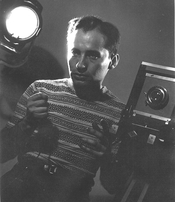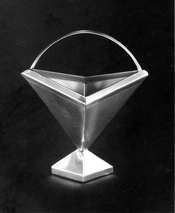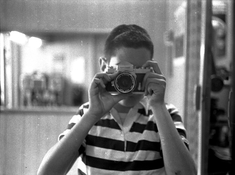FriedLouisStudio
Member
Hiya, folks!

I've just joined recently, but I'm 68 years old and have been a photographer nearly my whole life. My parents were professionals who opened their own little commercial studio in 1946 that lasted nearly 50 years. I grew up suffused in photography daily because it was the family business. I was put to work as soon as I was tall enough to peer over a developing tray!

By the time I was in 7th grade (1966), I was working after school nearly every day - loading 4x5 and 6x9 film holders, developing sheet film, rollfilm and 35mm, making prints, drying prints (a BIG job in the pre-RC paper era), holding reflectors, retouching, acting as a hand model, schlepping gear to location jobs, going out myself to shoot NYS liquor license photos at bars and restaurants, rewiring lights...

My dad had been an amateur before the war, then gravitated to photography during his army service (his last gig was running a darkroom staffed by civilian women in Gulfport, MS), and he attended the NYC School of Modern Photography in the studio's early days. When his original partner left, my mom joined in, and she also went to the School of Modern Photography. We were mainly a b/w shop, shooting nearly everything "important" on 4x5 sheet film with a Graphic View II.
Apart from an earlier period of shooting stereo slides on family vacations, 35mm didn't enter the picture until 1963, when we got a Nikkorex F and 50mm/f2 Nikkor. It was soon upgraded to a series of Nikkormats and Nikons, and eventually eight lenses. Medium format was represented by a series of Mamiya cameras - an original Mamiyaflex C, then a C330, and eventually a RB-67 Pro. But my dad was a sheet film Chauvanist, so we would only use the medium format cameras for "stuff that's going to be reproduced small."
The studio initially did everything (and always retained the motto "Photography In All Its Phases"), but by the time my memories start circa 1960, they'd stopped doing portraits, weddings, and baby pictures. They were concentrating on product shots. These were nearly all b/w, lit with fluorescent lights and/or photofloods and spotlights, on films like Plus-X and Ektapan 100.

A notable chunk of the business then was graphic arts work to support the local commercial artists, publishers, and print shops. Color separation negatives, halftone veloxes, resizing type and art, warping text into strange shapes, position stats... There was a whole realm of photographic techniques that would be obsoleted along with pasted-up mechanical artwork by computers within a couple of decades.

I've had LOTS of experience with older non-AI Nikons, Olympus OMs and half-frames, Minox subminis, and other gear. I was reading all the major photo magazines (as pros, we had free subscriptions to most for decades) from the mid-60s onward, and I saw all the new technologies as they appeared. There's a lot of stuff that's just received history to most of you that I experienced myself as it happened. (For example, I remember when the "Nikon shuffle" was introduced to index lenses to the light meter... and it was viewed as the height of sophistication, a brilliant solution... Rather than the "odd, awkward, hard to remember" procedure that I see constantly complained about in reviews of old Nikon gear by younger folks.)
I was never interested in taking over the photo business (I ended up as a tech writer working on software manuals for 35 years), but I never stopped shooting b/w, and I eventually inherited everything. These days I still shoot with classic gear - OM-2, Pen F, Nikon F2, Nikkormat, etc. - though I only scan my negatives now. Yeah, I have the old Omega D-3v and could set up a print darkroom... but I don't do enough to justify it, I only shoot six or eight rolls a year. And besides, were I to make a great traditional print, the very first thing I'd do is scan it for phone/internet viewing. So, while I do somewhat miss doing wet printing, I feel like I'm just cutting out the middleman.
The other thing I've been doing in recent years is adding commentary to photo forums (I've been on photo.net since the 90s) and discussion groups, trying to put some of my old-school knowledge out there for the edification of newbies. I joined here because I'm really impressed with the depth and detail of these forums, and it seemed like I belong, since I have a really unique POV on 60+ years of photo technology to contribute.
Anyhow, I'm very happy to be here!

I've just joined recently, but I'm 68 years old and have been a photographer nearly my whole life. My parents were professionals who opened their own little commercial studio in 1946 that lasted nearly 50 years. I grew up suffused in photography daily because it was the family business. I was put to work as soon as I was tall enough to peer over a developing tray!

By the time I was in 7th grade (1966), I was working after school nearly every day - loading 4x5 and 6x9 film holders, developing sheet film, rollfilm and 35mm, making prints, drying prints (a BIG job in the pre-RC paper era), holding reflectors, retouching, acting as a hand model, schlepping gear to location jobs, going out myself to shoot NYS liquor license photos at bars and restaurants, rewiring lights...

My dad had been an amateur before the war, then gravitated to photography during his army service (his last gig was running a darkroom staffed by civilian women in Gulfport, MS), and he attended the NYC School of Modern Photography in the studio's early days. When his original partner left, my mom joined in, and she also went to the School of Modern Photography. We were mainly a b/w shop, shooting nearly everything "important" on 4x5 sheet film with a Graphic View II.
Apart from an earlier period of shooting stereo slides on family vacations, 35mm didn't enter the picture until 1963, when we got a Nikkorex F and 50mm/f2 Nikkor. It was soon upgraded to a series of Nikkormats and Nikons, and eventually eight lenses. Medium format was represented by a series of Mamiya cameras - an original Mamiyaflex C, then a C330, and eventually a RB-67 Pro. But my dad was a sheet film Chauvanist, so we would only use the medium format cameras for "stuff that's going to be reproduced small."
The studio initially did everything (and always retained the motto "Photography In All Its Phases"), but by the time my memories start circa 1960, they'd stopped doing portraits, weddings, and baby pictures. They were concentrating on product shots. These were nearly all b/w, lit with fluorescent lights and/or photofloods and spotlights, on films like Plus-X and Ektapan 100.

A notable chunk of the business then was graphic arts work to support the local commercial artists, publishers, and print shops. Color separation negatives, halftone veloxes, resizing type and art, warping text into strange shapes, position stats... There was a whole realm of photographic techniques that would be obsoleted along with pasted-up mechanical artwork by computers within a couple of decades.

I've had LOTS of experience with older non-AI Nikons, Olympus OMs and half-frames, Minox subminis, and other gear. I was reading all the major photo magazines (as pros, we had free subscriptions to most for decades) from the mid-60s onward, and I saw all the new technologies as they appeared. There's a lot of stuff that's just received history to most of you that I experienced myself as it happened. (For example, I remember when the "Nikon shuffle" was introduced to index lenses to the light meter... and it was viewed as the height of sophistication, a brilliant solution... Rather than the "odd, awkward, hard to remember" procedure that I see constantly complained about in reviews of old Nikon gear by younger folks.)
I was never interested in taking over the photo business (I ended up as a tech writer working on software manuals for 35 years), but I never stopped shooting b/w, and I eventually inherited everything. These days I still shoot with classic gear - OM-2, Pen F, Nikon F2, Nikkormat, etc. - though I only scan my negatives now. Yeah, I have the old Omega D-3v and could set up a print darkroom... but I don't do enough to justify it, I only shoot six or eight rolls a year. And besides, were I to make a great traditional print, the very first thing I'd do is scan it for phone/internet viewing. So, while I do somewhat miss doing wet printing, I feel like I'm just cutting out the middleman.
The other thing I've been doing in recent years is adding commentary to photo forums (I've been on photo.net since the 90s) and discussion groups, trying to put some of my old-school knowledge out there for the edification of newbies. I joined here because I'm really impressed with the depth and detail of these forums, and it seemed like I belong, since I have a really unique POV on 60+ years of photo technology to contribute.
Anyhow, I'm very happy to be here!
Last edited:






